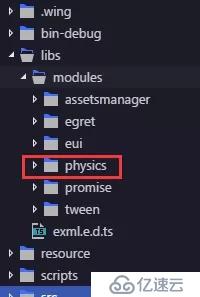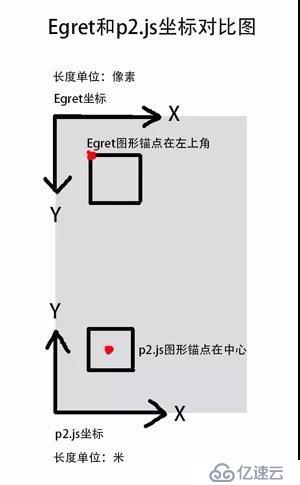您好,登錄后才能下訂單哦!
您好,登錄后才能下訂單哦!
今天分享的內容是:基于Egret使用P2物理引擎實現物理小球示例效果。
了解更多信息,您可以查看P2物理引擎GitHub地址或者是EgretP2物理系統文檔。
* 第三方庫的引入
* 創建一個P2物理項目一、第三方庫的引入
1.首先新建一個項目。
2.在GitHub上下載包括P2物理引擎庫的完整第三方庫,解壓后按照路徑找到physics模塊。

3.將physics模塊放到新建項目根目錄的同級目錄。
4.修改egretProperties.json,modules數組里增加
{
"name":"physics",
"path":"../physics"
}
5.然后找到插件-Egret項目工具-編譯引擎編譯一下就成功引入P2庫,如下圖。

二、創建一個P2物理項目
使用P2物理引擎創建物理應用的過程大致分為5個步驟:
1.創建world世界
2.創建shape形狀
3.創建body剛體
4.實時調用step()函數,更新物理模擬計算
5.基于形狀、剛體,使用Egret渲染,顯示物理模擬效果
**下面根據這5個步驟進行代碼構建。
1.打開Main.ts,首先創建world世界**
//創建Word世界
private world:p2.World;
private CreateWorld(){
this.world = new p2.World();
//設置world為睡眠狀態
this.world.sleepMode = p2.World.BODY_SLEEPING;
this.world.gravity = [0,1]
}gravity是一個Vector2向量對象,表示world世界中重力加速度,默認為垂直向上的向量[0,-9.81],將gravity設置為[0,0]可以取消重力;gravity的x分量也是有意義的,將其設置為一個非0數值后,重力就會朝向量[x,y]方向。
2.創建地板Plane
//生成地板Plane
private planeBody:p2.Body;
private CreatePlane(){
//創建一個shape形狀
let planeShape:p2.Plane = new p2.Plane();
//創建body剛體
this.planeBody= new p2.Body({
//剛體類型
type:p2.Body.STATIC,
//剛體的位置
position:[0,this.stage.stageHeight]
});
this.planeBody.angle = Math.PI;
this.planeBody.displays = [];
this.planeBody.addShape(planeShape);
this.world.addBody(this.planeBody);
}Plane相當于地面,默認面向Y軸方向。 因為這個Y軸是P2的Y軸,而不是Egret的Y軸。P2和Egret的Y軸是相反的。所以將地面翻轉180度。
planeBody.angle = Math.PI
3.點擊創建足球或者矩形方塊
private shpeBody:p2.Body;
//貼圖顯示對象
private display:egret.DisplayObject;
private onButtonClick(e:egret.TouchEvent) {
if(Math.random() >0.5){
//添加方形剛體
var boxShape:p2.Shape = new p2.Box({width:140 ,height:80});
this.shpeBody = new p2.Body({ mass: 1, position: [e.stageX, e.stageY], angularVelocity: 1});
this.shpeBody.addShape(boxShape);
this.world.addBody(this.shpeBody);
this. display= this.createBitmapByName("rect_png");
this.display.width = (<p2.Box>boxShape).width
this.display.height = (<p2.Box>boxShape).height
}
else{
//添加圓形剛體
var circleShape:p2.Shape = new p2.Circle({radius:60});
this.shpeBody = new p2.Body({ mass: 1, position: [e.stageX, e.stageY]});
this.shpeBody.addShape(circleShape);
this.world.addBody(this.shpeBody);
this.display = this.createBitmapByName("circle_png");
this.display.width = (<p2.Circle>circleShape).radius * 2
this.display.height = (<p2.Circle>circleShape).radius * 2
}
this.display.anchorOffsetX = this.display.width / 2
this.display.anchorOffsetY = this.display.height / 2;
this.display.x = -100;
this.display.y = -100;
this.display.rotation = 270
this.shpeBody.displays = [this.display];
this.addChild(this.display);
}上述代碼中先創建Box或者Circle形狀,并通過addShape()函數,將其添加到剛體body中,最后通過world的addBody()將剛體添加到世界中,完成一個P2物理應用創建。 注意:Egret中加載進來的圖像,其原點默認為左上角,而P2中剛體的原點處于其中心位置,如下圖(盜了一張圖)

所以需要根據剛體重心坐標偏移量(offsetX,offsetY)設置圖像的anchorOffsetX ,anchorOffsetY 屬性。
4.幀函數實時調用step()函數
//幀事件,步函數
private update() {
this.world.step(2.5);
var l = this.world.bodies.length;
for (var i:number = 0; i < l; i++) {
var boxBody:p2.Body = this.world.bodies[i];
var box:egret.DisplayObject = boxBody.displays[0];
if (box) {
//將剛體的坐標和角度賦值給顯示對象
box.x = boxBody.position[0];
box.y = boxBody.position[1];
box.rotation = boxBody.angle * 180 / Math.PI;
//如果剛體當前狀態為睡眠狀態,將圖片alpha設為0.5,否則為1
if (boxBody.sleepState == p2.Body.SLEEPING) {
box.alpha = 0.5;
}
else {
box.alpha = 1;
}
}
}
}world中所有的剛體都保存在屬性bodies數組中,通過數組的foreach()方法,可以遍歷其中的每一個body,然后拿到body的顯示對象,再將剛體的坐標和角度屬性賦值給顯示對象,實時更新即可。
5.在createGameScene()中依次調用
protected createGameScene(): void {
let img:egret.Bitmap = new egret.Bitmap();
img = this.createBitmapByName("bg_jpg");
img.width = this.stage.stageWidth;
img.height = this.stage.stageHeight;
this.addChild(img);
this.CreateWorld();
this.CreatePlane();
this.addEventListener(egret.Event.ENTER_FRAME,this.update,this);
this.stage.addEventListener(egret.TouchEvent.TOUCH_BEGIN,this.onButtonClick,this);
}本教程所涉及的內容,只是對P2物理引擎的初級了解和使用。然而物理引擎需要我們學習的知識還有很多,還有更強大更好玩的功能等待我們去探索!
附上GitHub源碼地址:https://github.com/duan003387...
免責聲明:本站發布的內容(圖片、視頻和文字)以原創、轉載和分享為主,文章觀點不代表本網站立場,如果涉及侵權請聯系站長郵箱:is@yisu.com進行舉報,并提供相關證據,一經查實,將立刻刪除涉嫌侵權內容。